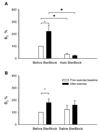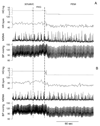The role of the cyclooxygenase products in evoking sympathetic activation in exercise
- PMID: 17604332
- PMCID: PMC2559802
- DOI: 10.1152/ajpheart.00258.2007
The role of the cyclooxygenase products in evoking sympathetic activation in exercise
Abstract
Animal studies suggest that prostaglandins in skeletal muscles stimulate afferents and contribute to the exercise pressor reflex. However, human data regarding a role for prostaglandins in this reflex are varied, in part because of systemic effects of pharmacological agents used to block prostaglandin synthesis. We hypothesized that local blockade of prostaglandin synthesis in exercising muscles could attenuate muscle sympathetic nerve activity (MSNA) responses to fatiguing exercise. Blood pressure (Finapres), heart rate, and MSNA (microneurography) were assessed in 12 young healthy subjects during static handgrip and postexercise muscle ischemia (PEMI) before and after local infusion of 6 mg of ketorolac tromethamine in saline via Bier block (regional intravenous anesthesia). In the second experiment (n = 10), the same amount of saline was infused via the Bier block. Ketorolac Bier block decreased the prostaglandins synthesis to approximately 33% of the baseline. After ketorolac Bier block, the increases in MSNA from the baseline during the fatiguing handgrip was significantly lower than that before the Bier block (before ketorolac: Delta502 +/- 111; post ketorolac: Delta348 +/- 62%, P = 0.016). Moreover, the increase in total MSNA during PEMI after ketorolac was significantly lower than that before the Bier block (P = 0.014). Saline Bier block had no similar effect. The observations indicate that blockade of prostaglandin synthesis attenuates MSNA responses seen during fatiguing handgrip and suggest that prostaglandins contribute to the exercise pressor reflex.
Figures




Similar articles
-
Cyclooxygenase inhibition attenuates sympathetic responses to muscle stretch in humans.Am J Physiol Heart Circ Physiol. 2008 Jun;294(6):H2693-700. doi: 10.1152/ajpheart.91505.2007. Epub 2008 Apr 25. Am J Physiol Heart Circ Physiol. 2008. PMID: 18441194 Free PMC article. Clinical Trial.
-
Local adenosine receptor blockade accentuates the sympathetic responses to fatiguing exercise.Am J Physiol Heart Circ Physiol. 2010 Jun;298(6):H2130-7. doi: 10.1152/ajpheart.00083.2010. Epub 2010 Apr 16. Am J Physiol Heart Circ Physiol. 2010. PMID: 20400689 Free PMC article.
-
Acid-sensing ion channels blockade attenuates pressor and sympathetic responses to skeletal muscle metaboreflex activation in humans.J Appl Physiol (1985). 2019 Nov 1;127(5):1491-1501. doi: 10.1152/japplphysiol.00401.2019. Epub 2019 Sep 23. J Appl Physiol (1985). 2019. PMID: 31545154
-
Local prostaglandin blockade attenuates muscle mechanoreflex-mediated renal vasoconstriction during muscle stretch in humans.Am J Physiol Heart Circ Physiol. 2008 May;294(5):H2184-90. doi: 10.1152/ajpheart.00948.2007. Epub 2008 Mar 7. Am J Physiol Heart Circ Physiol. 2008. PMID: 18326807 Free PMC article. Clinical Trial.
-
Cyclooxygenase products sensitize muscle mechanoreceptors in healthy humans.Am J Physiol Heart Circ Physiol. 2004 Nov;287(5):H1944-9. doi: 10.1152/ajpheart.00329.2004. Am J Physiol Heart Circ Physiol. 2004. PMID: 15475528 Clinical Trial.
Cited by
-
Evidence for sensitized fatigue pathways in patients with chronic fatigue syndrome.Pain. 2015 Apr;156(4):750-759. doi: 10.1097/j.pain.0000000000000110. Pain. 2015. PMID: 25659069 Free PMC article.
-
Effect of Cyclooxygenase Inhibition on Peripheral Venous Distension Reflex in Healthy Humans.Hypertension. 2023 May;80(5):1102-1109. doi: 10.1161/HYPERTENSIONAHA.122.20506. Epub 2023 Mar 21. Hypertension. 2023. PMID: 36942572 Free PMC article.
-
Thromboxane A2 receptors contribute to the exaggerated exercise pressor reflex in male rats with heart failure.Physiol Rep. 2021 Sep;9(18):e15052. doi: 10.14814/phy2.15052. Physiol Rep. 2021. PMID: 34558221 Free PMC article.
-
Combined, but not individual, blockade of ASIC3, P2X, and EP4 receptors attenuates the exercise pressor reflex in rats with freely perfused hindlimb muscles.J Appl Physiol (1985). 2015 Dec 1;119(11):1330-6. doi: 10.1152/japplphysiol.00630.2015. Epub 2015 Oct 15. J Appl Physiol (1985). 2015. PMID: 26472871 Free PMC article.
-
Cyclooxygenase products contribute to the exaggerated exercise pressor reflex evoked by static muscle contraction in male UCD-type 2 diabetes mellitus rats.J Appl Physiol (1985). 2024 May 1;136(5):1226-1237. doi: 10.1152/japplphysiol.00879.2023. Epub 2024 Mar 28. J Appl Physiol (1985). 2024. PMID: 38545661 Free PMC article.
References
-
- Chapleau MW, Hajduczok G, Abboud FM. Paracrine role of prostanoids in activation of arterial baroreceptors: an overview. Clin Exp Hypertens A. 1991;13:817–824. - PubMed
-
- Chen HI, Chapleau MW, McDowell TS, Abboud FM. Prostaglandins contribute to activation of baroreceptors in rabbits. Possible paracrine influence of endothelium. Circ Res. 1990;67:1394–1404. - PubMed
-
- Cryer B, Feldman M. Cyclooxygenase-1 and cyclooxygenase-2 selectivity of widely used nonsteroidal anti-inflammatory drugs. Am J Med. 1998;104:413–421. - PubMed
-
- Cui J, Zhang R, Wilson TE, Crandall CG. Spectral analysis of muscle sympathetic nerve activity in heat-stressed humans. Am J Physiol Heart Circ Physiol. 2004;286:H1101–H1106. - PubMed
-
- Davy KP, Herbert WG, Williams JH. Effect of indomethacin on the pressor responses to sustained isometric contraction in humans. J Appl Physiol. 1993;75:273–278. - PubMed
Publication types
MeSH terms
Substances
Grants and funding
LinkOut - more resources
Full Text Sources
Medical

